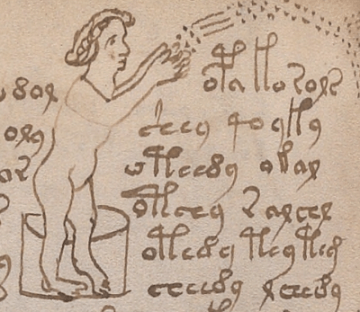Justin E. H. Smith at his own site:
 I think I’m finally ready to come out as a Voynich scholar. I’ve been studying hi-res scans of the manuscript off and on for four years or so, and I’ve been reading the so-called secondary literature for about a year. What compels me to come out is the discovery over this past year that for the most part commentators really do not know what they are doing. They divide roughly into two camps: the cryptographers and information scientists, on the one hand (the “quants”, as we say), and on the other hand the ravers and enthusiasts, the people who do not know how to distinguish between gut feelings and real evidence. There seem to be very few proper palaeographers writing about this text: that is, people who know how to attend to handwriting and codicological evidence until plausible patterns of intention begin to emerge. It may be that such people are scared away by the ravers; one need only briefly glance at a list of all the time-travel, Illuminati, and UFOlogical theories the manuscript has inspired to see that it is a real intellectual danger zone. For me it is however a wonderful case study and autoexperiment in the use of abductive inference. I do not yet think I know anything with certainty that no other researcher has established before me. But over time a picture is emerging that leads me to lend significant credence to some explanations over others.
I think I’m finally ready to come out as a Voynich scholar. I’ve been studying hi-res scans of the manuscript off and on for four years or so, and I’ve been reading the so-called secondary literature for about a year. What compels me to come out is the discovery over this past year that for the most part commentators really do not know what they are doing. They divide roughly into two camps: the cryptographers and information scientists, on the one hand (the “quants”, as we say), and on the other hand the ravers and enthusiasts, the people who do not know how to distinguish between gut feelings and real evidence. There seem to be very few proper palaeographers writing about this text: that is, people who know how to attend to handwriting and codicological evidence until plausible patterns of intention begin to emerge. It may be that such people are scared away by the ravers; one need only briefly glance at a list of all the time-travel, Illuminati, and UFOlogical theories the manuscript has inspired to see that it is a real intellectual danger zone. For me it is however a wonderful case study and autoexperiment in the use of abductive inference. I do not yet think I know anything with certainty that no other researcher has established before me. But over time a picture is emerging that leads me to lend significant credence to some explanations over others.
I am, say, 85-90% certain that the manuscript is not a hoax, or, if it is a hoax, it is one that was perpetuated long before the manuscript came into Wilfrid Voynich’s possession in 1912. I am attracted to the idea that, if it is a hoax, this was a hoax perpetuated on Athanasius Kircher, the one-time owner of the manuscript who was known to hastily claim to have cracked other codes (e.g., Egyptian hieroglyphics), and whom his contemporaries may have wanted to expose in his rashness by sending him a nonsense text to interpret. But this is a low-probability explanation. I am, say, 80-90% certain that the text was in the possession of a German, Dutch, or Flemish scholar who knew Latin, but that the manuscript itself is not written in any of these languages.
More here.
